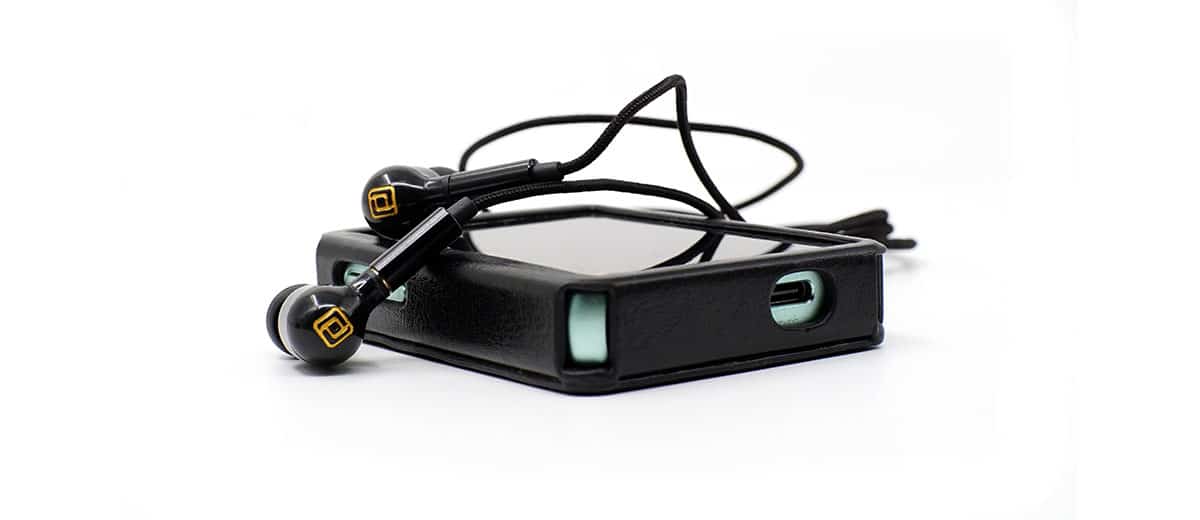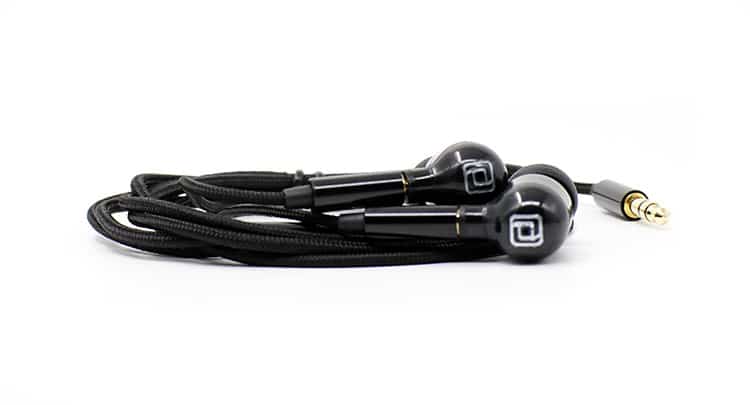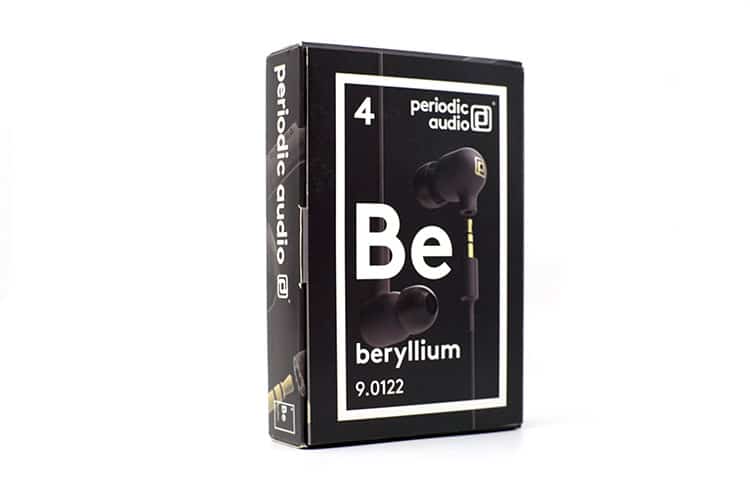Select Comparisons
Periodic Audio Magnesium V3
$199
Technical
The Periodic Audio Magnesium V3 and Beryllium V3 both have a single dynamic driver. The difference is the material of their diaphragm. The Magnesium V3 has a magnesium diaphragm material while the Beryllium V3 has a beryllium diaphragm material.
Design
In terms of design, these 2 monitors are identical to each other, but with a gold-colored emblem compared to Magnesium V3’s silver. Both have the same shell material and shell design – a black bullet-type IEM. Same with the Magnesium V3, the Beryllium V3 has a 2.5mm termination with a 3.5mm straight plug termination.
Performance
Both monitors offer excellent bass quantity. Out of the two, the Beryllium V3 delivers the deeper and fuller punch with its sub-bass.
Mid-bass is also more articulate and detailed on the Beryllium V3 whereas the Magnesium plays more on the quantity over quality. If you’re the type who wants the best bass you can get, the Beryllium would be the better choice.
The midrange of the Beryllium V3 is more forward than the Magnesium V3, although not by much. The two sound very similar, with a slight warm tint which makes it feel very inviting to listen to.
The main difference between the two would be the level of detail and clarity. When listening very closely to both, the Magnesium V3 has some low noise distortion that is not really noticeable but is picked up when compared.
The Magnesium V3’s treble position is more forward and more energetic out of the two. Both have an adequate airy top, which balances the heavy lows produced by both monitors. The Magnesium does seem to have a crisper treble, with cymbal crashes feeling a lot splashier.
Although Beryllium has a more tamed treble than Magnesium, it does have a smoother textured treble region. Similar to the monitor’s midrange, the Beryllium has a much cleaner and smoother presentation.
The soundstage of the two is very similar. Both have a deep and tall height, despite their rather not-so-spacious width. Imaging is definitely better with the Beryllium. It’s more projected in a multidimensional space than the Magnesium V3.
Overall, in terms of tuning, Magnesium V3 is the Beryllium V3’s baby brother. They have very similar tuning with their deep lows and non-recessed midrange. However, the Beryllium takes it a notch higher with its refinements, giving a fuller and more natural listening experience.
Periodic Audio Titanium V3
$299
Technical
The Periodic Audio Titanium V3 and Beryllium V3 both have a single dynamic driver. The difference lies with their transducer material, which differs in sound replication properties.
The Titanium V3 has a titanium diaphragm material while the Beryllium V3 has a beryllium diaphragm material.
Design
In terms of design, these 2 monitors are identical to each other, but with a gold-colored emblem compared to Titanium V3’s silver. Apart from that, they’re practically identical. Both monitors have the same shell material and shell design. They also both come in a 2.5mm termination with a 3.5mm straight plug termination.
Performance
Bass quantity and quality of both monitors are really good on both monitors. Both have a fantastic sub-bass rumble with good mid-bass articulation. Although, if I were to nitpick, I like Beryllium V3’s presentation better with its controlled punches. It dips very low while maintaining a fuller tonality than the Titanium.
The midrange tuning on the Beryllium V3 is completely different from the Titanium V3. It has a more elevated midrange, which delivers a better lower and upper midrange body.
The Titanium’s midrange rather feels thin and hollow when compared to what the Beryllium V3 brings. Vocals on the Beryllium V3 are more heard, which really blends with the bass quantity given by these drivers.
Comparing the treble of monitors, the Titanium V3’s treble is a bit more elevated than the Beryllium V3. However, the Beryllium V3’s treble does sound smoother and more natural overall.
Strums are crisper on the Beryllium V3s, similar to how you hear it live. The Beryllium V3 also has a better treble extension with its airer top, which was lacking with the Titanium.
One thing I noticed with Periodic Audio monitors is that the soundstage is quite intimate. They make up for it with its impressive depth, which is very hard to beat. Both monitors’ width is quite similar, with the Beryllium V3 performing a bit better, but nothing exemplary.
Imaging is also better on the Beryllium V3, it delivers a better vocal layering. Multiple notes have more gaps and are heard better on the Beryllium V3.
Tin HiFi P2
$369
Technical
The Tin HiFi P2 is equipped with a planar magnetic driver. The Beryllium V3 on the other hand is composed of a single dynamic driver with a beryllium diaphragm.
Design
The TIN HiFi P2 is enclosed in a satin-finished stainless-steel chassis which encloses a large 12mm planar magnetic driver.
The P2 has an ear-hook design, with a universal 0.78mm 2 pin termination, while the Beryllium V3 has a bullet design, with Periodic Audio’s IDEEL 2.5mm termination.
The P2 is more versatile with its offerings – a 2.5mm plug with 2 adaptors – a female 2.5mm to 3.5mm male single-ended connection and a female 2.5mm to 4.4mm male balanced connection, making it flexible to use across different players. Unfortunately, the Periodic Audio standard is only a 3.5mm SE termination.
Performance
The two monitors have very different tuning. The P2 are relatively flat, with a forward midrange while the Beryllium is tuned to be an all-arounder with its balanced tuning and deep lows
Speaking of lows, Beryllium V3 is loaded with it. The P2 does go low but compared to the Beryllium, it rather feels dull. The Beryllium V3 has a substantial impact that is on the league of its own. When listening to neo-soul or even reggae, it does project the deep bass hits better than the P2.
The P2 has the typical planar texture mids, which are articulate but sound artificial at times. The Beryllium sounds a lot more natural, which is produced by its single dynamic driver.
Comparing the 2 side by side, the level of articulation is at par, and minute details are heard, without advantage over the other. The main difference would be the coloration as the P2 leans on the cold side while the Beryllium V3 is mostly neutral, with a very small hint of warmness in them.
The presentation of the treble with these two monitors is very different. For one, the P2 is known to be on the bright side, and it shows when compared with the Beryllium V3. The treble on the P2 is on the aggressive side while the Beryllium V3, although not treble shy, is more tuned to be laid back with a decent snap and sparkle in higher frequencies.
The sound stage and imaging are significantly better on the P2. The BerylliumV3 is definitely more intimate than the P2, albeit taller and deeper.
Do note that the P2 is power-hungry IEMs. It needs a dedicated DAP to properly power them. The Beryllium V3 on the other hand does not. Whether you’re playing it with your phone or a more powerful DAP, both are okay.
Our Verdict
This is the third installment of my reviews on Periodic Audio and I have been constantly impressed by their offerings. The sound refinements of the different monitors progressively go higher in their offerings.
The Beryllium really has exceptional clarity and is so pleasantly tuned with a low noise floor making the attacks more impactful and enjoyable.
The only caveat in these monitors is their relatively intimate soundstage. You could do well with similarly priced monitors with a more expansive soundstage.
Despite its relatively intimate soundstage, I would still say this is a competitive monitor in its price range. It’s a good overall monitor that gives you good bass and a rich midrange region. This can really be “Your Endgame”.
Similar to the other Periodic Audio lineup, this monitor is so simple and fun to listen to. It is a no-fuss and hassle-free equipment that can take with you on your adventures.
Periodic Audio Beryllium V3 Specifications
- Frequency Response 12 Hz to 45 kHz
- Impedance 32 Ohms nominal
- Sensitivity 100 dB SPL at 1mW in ear
- Power Handling 200 mW continuous
- Peak SPL 123 dB
- THD Less than 1% THD at 1mW





